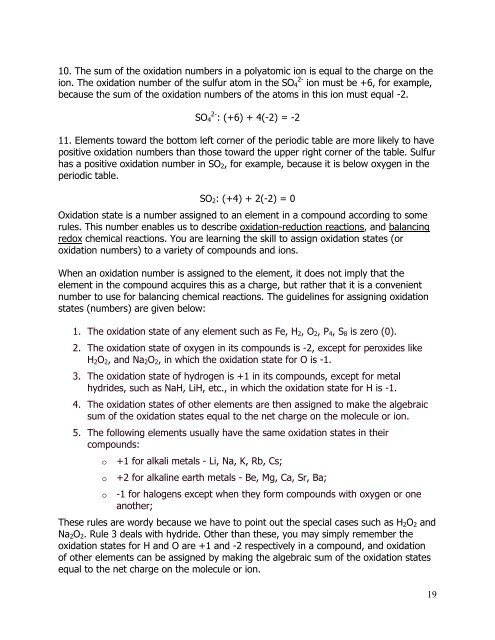Electrons and Quantum Mechanics - Oakland Schools
Electrons and Quantum Mechanics - Oakland Schools
Electrons and Quantum Mechanics - Oakland Schools
You also want an ePaper? Increase the reach of your titles
YUMPU automatically turns print PDFs into web optimized ePapers that Google loves.
10. The sum of the oxidation numbers in a polyatomic ion is equal to the charge on the<br />
ion. The oxidation number of the sulfur atom in the SO 4 2- ion must be +6, for example,<br />
because the sum of the oxidation numbers of the atoms in this ion must equal -2.<br />
SO 4 2- : (+6) + 4(-2) = -2<br />
11. Elements toward the bottom left corner of the periodic table are more likely to have<br />
positive oxidation numbers than those toward the upper right corner of the table. Sulfur<br />
has a positive oxidation number in SO 2 , for example, because it is below oxygen in the<br />
periodic table.<br />
SO 2 : (+4) + 2(-2) = 0<br />
Oxidation state is a number assigned to an element in a compound according to some<br />
rules. This number enables us to describe oxidation-reduction reactions, <strong>and</strong> balancing<br />
redox chemical reactions. You are learning the skill to assign oxidation states (or<br />
oxidation numbers) to a variety of compounds <strong>and</strong> ions.<br />
When an oxidation number is assigned to the element, it does not imply that the<br />
element in the compound acquires this as a charge, but rather that it is a convenient<br />
number to use for balancing chemical reactions. The guidelines for assigning oxidation<br />
states (numbers) are given below:<br />
1. The oxidation state of any element such as Fe, H 2 , O 2 , P 4 , S 8 is zero (0).<br />
2. The oxidation state of oxygen in its compounds is -2, except for peroxides like<br />
H 2 O 2 , <strong>and</strong> Na 2 O 2 , in which the oxidation state for O is -1.<br />
3. The oxidation state of hydrogen is +1 in its compounds, except for metal<br />
hydrides, such as NaH, LiH, etc., in which the oxidation state for H is -1.<br />
4. The oxidation states of other elements are then assigned to make the algebraic<br />
sum of the oxidation states equal to the net charge on the molecule or ion.<br />
5. The following elements usually have the same oxidation states in their<br />
compounds:<br />
o<br />
o<br />
o<br />
+1 for alkali metals - Li, Na, K, Rb, Cs;<br />
+2 for alkaline earth metals - Be, Mg, Ca, Sr, Ba;<br />
-1 for halogens except when they form compounds with oxygen or one<br />
another;<br />
These rules are wordy because we have to point out the special cases such as H 2 O 2 <strong>and</strong><br />
Na 2 O 2 . Rule 3 deals with hydride. Other than these, you may simply remember the<br />
oxidation states for H <strong>and</strong> O are +1 <strong>and</strong> -2 respectively in a compound, <strong>and</strong> oxidation<br />
of other elements can be assigned by making the algebraic sum of the oxidation states<br />
equal to the net charge on the molecule or ion.<br />
19
















